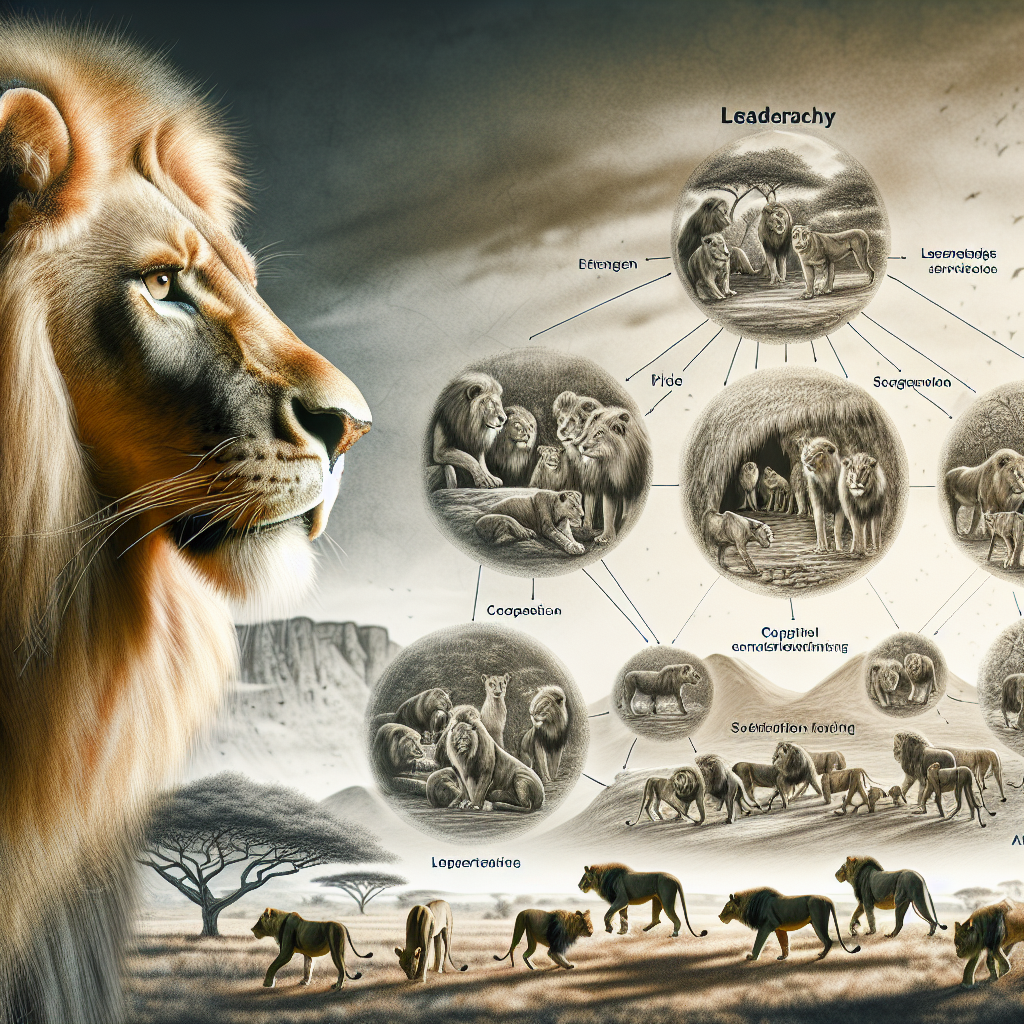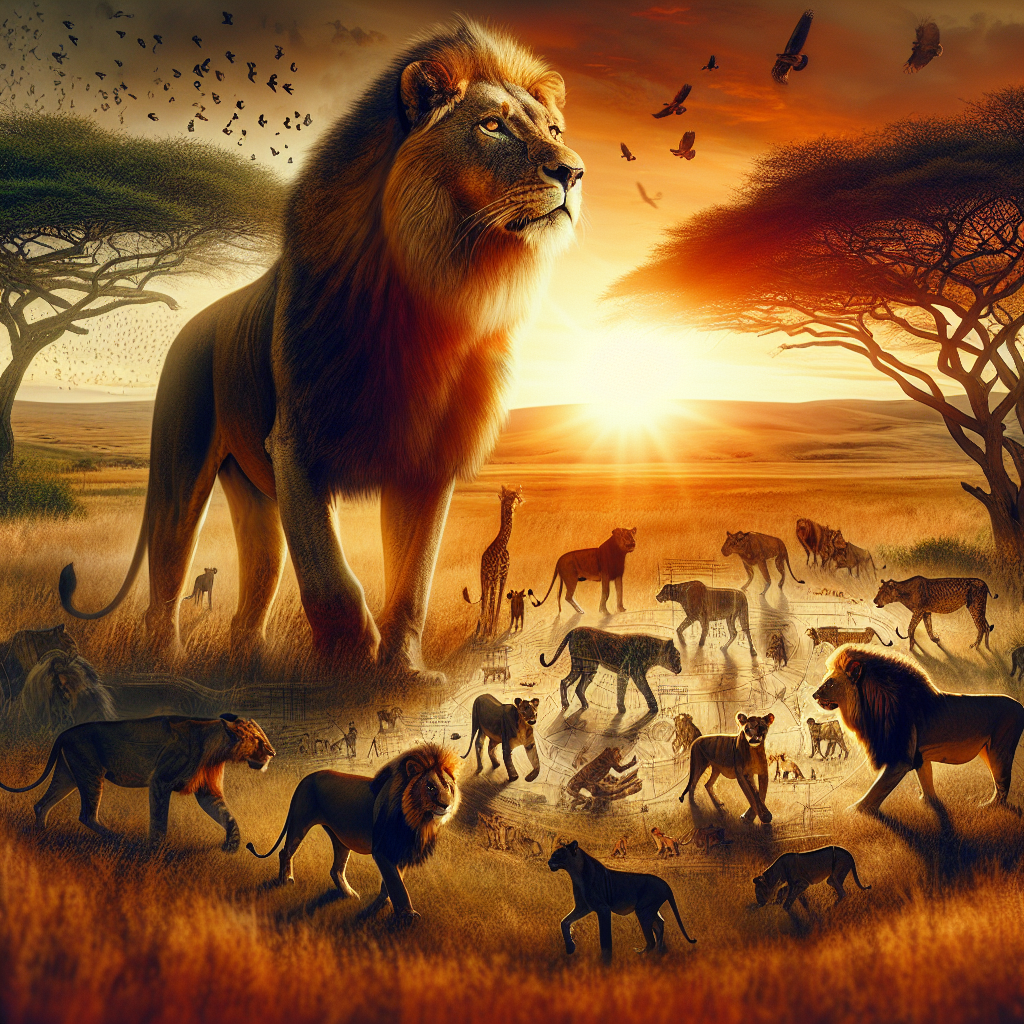So you’re curious about the intricate social structure of lions? Well, you’re in the right place! In this article, we’ll be delving into the fascinating world of lion socialization, drawing insights straight from the encyclopedia. Lions, known as the kings of the jungle, have a complex network of relationships and hierarchies that shape their behavior and survival. From their pride dynamics to their hunting strategies, we’ll explore how lions navigate their social landscape and maintain their royal status. So without further ado, let’s embark on this wild journey of discovery into the world of lion social structure.
Introduction
Lions, the majestic creatures of the wild, have captured our imaginations for centuries. From their magnificent physical features to their complex social structure, these big cats never fail to fascinate us. In this article, we will delve into the intricate world of lion social structure in the wild, exploring their physical characteristics, principle roles within the pride, dominance and hierarchy, territorial behavior, communication methods, reproductive behavior, pride dynamics, specific case studies, and the impact of human activity on their existence.
Physical Structure
Size and Weight
When it comes to size and weight, lions truly live up to their title as the “king of the jungle.” Adult male lions can reach lengths of up to 10 feet from head to tail, while standing at an impressive height of around 4 feet at the shoulder. These regal creatures can weigh anywhere between 330 to 550 pounds. On the other hand, lionesses are noticeably smaller, measuring around 9 feet long and weighing between 265 to 395 pounds. The stark size difference between the sexes is a significant aspect of lion social structure.
Mane
One of the most distinguishing features of male lions is their majestic mane. Acting as a symbol of power and dominance, the mane is a striking characteristic that sets them apart from their female counterparts. The length and color of a lion’s mane can vary greatly, with factors such as genetics, age, and environmental conditions playing a role. A full, dark, and voluminous mane is often an indication of a healthy and dominant male.
Paw Structure
Lions are known for their powerful and agile movements, and their paw structure plays a vital role in enabling this. Equipped with retractable claws and specialized pads, lion paws provide the necessary traction for quick acceleration and sharp turns during hunts. Additionally, the pads act as shock absorbers, allowing lions to move silently through their surroundings.

Principle Roles
The Pride
The pride is at the heart of lion social structure. It consists of a group of lions, usually ranging from 10 to 30 individuals, comprising both adult males and females, as well as their cubs. The pride serves as a cohesive unit that provides protection, support, and hunting opportunities for its members. It forms a stable social structure, interwoven with a complex web of relationships and hierarchies.
Lionesses
In the lion social structure, lionesses play a vital role in maintaining the pride’s functioning. They are the primary hunters, working together to bring down large prey for the group to feed on. With their exceptional teamwork and hunting skills, lionesses showcase their strong bonds and cooperative nature. They are also responsible for rearing and nurturing the cubs, ensuring the survival and growth of future generations.
Male Lions
Adult male lions play a crucial role in defending the pride and maintaining dominance within their territory. They are the iconic image of strength and power, protecting the pride from external threats such as rival male lions or predators. Male lions also participate in hunting, though their main focus is guarding the pride’s territory and ensuring the continuity of their genetic lineage.
Hierarchy and Dominance
Dominant Males
The hierarchy within a lion pride is primarily determined by dominant males, often referred to as “pride males” or “king lions.” These dominant males hold exclusive mating rights within the pride and are responsible for defending their territory from rival males seeking to take over. They use their powerful roars and physical presence to assert dominance and secure their position as the leaders of the pride.
Subordinate Males
While dominant males hold the highest rank in lion social structure, there are often subordinate males within the pride. These individuals are usually younger or less experienced lions who have yet to challenge the dominant male for control. Subordinate males provide support to the dominant males in maintaining the pride’s territory and may eventually have the opportunity to rise in rank if the dominant male weakens or loses his position.
Lionesses’ Hierarchy
Within the pride, lionesses also have a hierarchical structure. Older lionesses often hold higher rank and exert influence over the group. This hierarchy affects the allocation of resources, hunting strategies, and social dynamics within the pride. However, unlike the male dominance hierarchy, the lioness hierarchy is not as rigid and can be influenced by various factors such as age, experience, and individual assertiveness.

Territory and Hunting
Pride Territories
Lions are highly territorial animals, with each pride defending a distinct area that provides resources such as food, water, and shelter. Pride territories can range from a few square miles to hundreds of square miles, depending on the availability of resources and population density. The size of a pride’s territory is directly influenced by factors such as prey abundance, competition from other prides, and environmental conditions.
Hunting Strategies
As skilled cooperative hunters, lions employ various strategies to secure their meals. Lionesses, with their agility and teamwork, form intricate hunting formations, surrounding their chosen prey and executing a well-coordinated attack. This collaborative effort increases the pride’s chances of a successful hunt and ensures a sufficient food supply for all members. Male lions, although not as involved in hunting as lionesses, may assist in taking down larger prey or guarding the kill from scavengers.
Communication within the Pride
Vocalizations
Communication plays a vital role in maintaining social cohesion within a pride. Lions utilize a wide range of vocalizations to convey different messages to their fellow pride members. The most well-known vocalization is the roar, a deep and resonant call that can be heard from miles away. Roaring serves as a territorial marker, an assertion of dominance, or a means of locating other members. Other vocalizations include grunts, growls, snarls, and purrs, each serving a specific communicative purpose.
Visual Cues
Visual cues also play an essential role in lion communication. Facial expressions, body postures, and tail movements are some of the ways lions convey their intentions and emotions to one another. From a gentle head rub to an assertive tail flick, these visual cues help maintain order and mediate interactions within the pride.
Scent Marking
Scent marking is another crucial aspect of lion communication. Lions possess scent glands on various parts of their body, such as their cheeks and feet, which they use to mark their presence on objects within their territory. These scent marks contain valuable information such as the pride’s identity or reproductive status. By leaving their scent behind, lions establish territorial boundaries and communicate with other individuals in the area.
Reproductive Behavior
Mating Rituals
Mating rituals within lion social structure occur when a dominant male successfully asserts his dominance and mates with the lionesses in the pride. These rituals involve complex courtship displays, which may include gentle nudges, head rubs, and mutual grooming. Mating can be a noisy affair, with loud vocalizations and physical interactions displaying the lion’s reproductive intentions.
Lionesses’ Reproductive Cycle
Lionesses experience an estrous cycle, or heat, lasting around four to six days. During this period, they are most receptive to mating. The synchrony of estrous cycles among lionesses within a pride increases the chances of successful reproduction and ensures that the cubs are born around the same time. This synchronization also facilitates cooperative care and nursing of the cubs by the lionesses.
Infanticide
Infanticide, although a ruthless behavior, is an integral part of lion social structure. When a new dominant male takes over a pride, he may kill the existing cubs sired by the previous dominant male. This behavior serves two purposes: eliminating competition for future offspring and bringing the lionesses back into estrus, thus allowing the new dominant male to propagate his genetic lineage.
Pride Dynamics
Immigration
Immigration is an important factor in lion social structure, enabling the infusion of new genetic material into a pride. Young males, after reaching maturity, often leave their natal pride to seek out opportunities for mating and territory control. They venture into new territories, sometimes battling with established dominant males, in the hope of establishing their own pride.
Emigration
On the other hand, lionesses rarely leave their pride. They mostly remain within their natal group, forming strong bonds with their sisters and maternal relatives. This lack of emigration helps maintain the stability and continuity of the pride.
Dispersal of Young Males
Dispersal of young males, which often occurs between the ages of two to three years old, plays a crucial role in minimizing inbreeding and promoting genetic diversity within lion populations. These young males leave their natal pride to avoid competition with dominant males and seek new territories to establish their own prides in the future.
Specific Case Studies
The Serengeti Lions
The lions of the Serengeti provide us with valuable insights into lion social structure. These iconic lions inhabit vast savannahs and form large prides, consisting of multiple adult males and an extensive network of females and cubs. The rich prey availability in the Serengeti allows for successful reproduction and the survival of these magnificent cats.
The Tsavo Lions
The Tsavo lions, found in the Tsavo National Park in Kenya, offer a unique case study in lion social structure. Unlike most lions, Tsavo males lack a pronounced mane due to environmental factors such as heat and low humidity. These lions exhibit a more solitary lifestyle, with limited associations with other males. The Tsavo lions highlight the incredible adaptability of lions to different environments and challenges.
Impact of Human Activity
Hunting and Poaching
Human activity has had a profound impact on lion populations worldwide. Historically, lions faced significant hunting pressure, mainly for sport and trophy hunting. Although these practices have been curtailed in many regions, poaching continues to pose a threat to these magnificent creatures. The illegal wildlife trade, fueled by the demand for lion bones and body parts, further exacerbates the challenges faced by lions in the wild.
Habitat Loss and Fragmentation
Habitat loss and fragmentation due to human encroachment is another significant concern for lion populations. As humans expand into lion territories, their natural habitats shrink, disrupting the delicate balance of lion social structure. Fragmentation of lion populations can lead to increased inbreeding and reduced genetic diversity, making them more susceptible to diseases and environmental changes.
Conservation Efforts
Fortunately, numerous conservation organizations and initiatives are working tirelessly to protect lions and their habitats. Efforts include establishing protected areas, implementing anti-poaching measures, and promoting community-based conservation programs. By recognizing the importance of lion social structure and taking action to preserve their habitats, we can work towards ensuring the continued existence of these majestic animals for future generations to appreciate and admire.
In conclusion, lion social structure in the wild is a complex and fascinating phenomenon. From their physical attributes to their intricate hierarchy and communication methods, lions exhibit remarkable adaptations for survival and procreation. However, the impact of human activities poses significant threats to their existence. By understanding and appreciating the intricacies of lion social structure, we can strive to protect and preserve these iconic creatures for generations to come.

